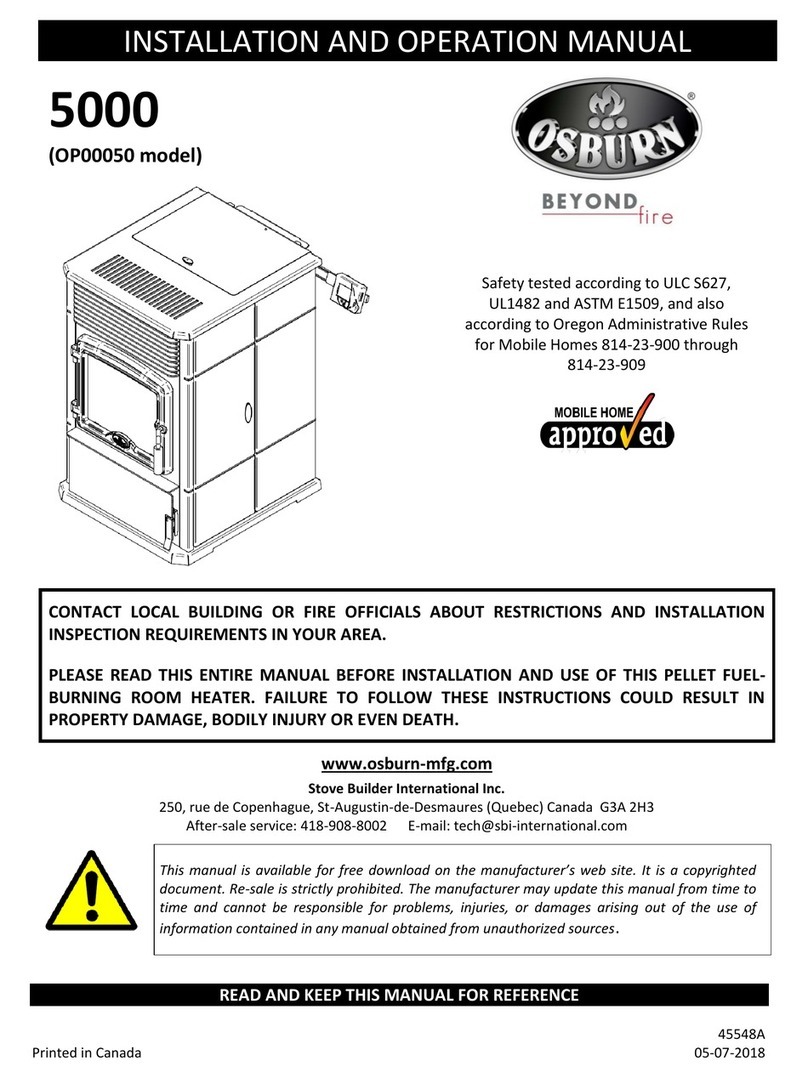
7000 Pellet Stove Installation and Operation Manual
___________________________________________________________________________________________________ 3
Table of contents
1 INTRODUCTION ....................................................................................................................................... 5
1.1 About Pellet Heating .............................................................................................................................. 5
1.1.1 Top 10 Reasons for Buying a Pellet Stove ................................................................................... 5
1.2 Appliance performance(1) ...................................................................................................................... 6
1.3 General Features .................................................................................................................................. 7
1.4 Overall Exterior Dimensions .................................................................................................................. 8
PART A – INSTALLATION ................................................................................................................................ 9
2 Installation Safety Information ............................................................................................................... 9
2.1 Installation Warnings, Cautions and Recommendations ...................................................................... 9
2.2 Regulations Covering Pellet Stove Installation ................................................................................... 10
2.3 Before Operating Your Stove .............................................................................................................. 11
3 Clearances to Combustible Material.................................................................................................... 12
3.1 Certification Label Location ................................................................................................................. 12
3.2 Minimum Clearances to Combustibles ................................................................................................ 12
3.3 Back Wall Installation .......................................................................................................................... 13
3.4 Corner Installation ............................................................................................................................... 13
3.5 Ceiling Clearances .............................................................................................................................. 14
3.6 Floor Protection ................................................................................................................................... 14
4 Venting system ...................................................................................................................................... 15
4.1 General ................................................................................................................................................ 15
4.2 Recommendations .............................................................................................................................. 15
4.3 Equivalent Vent Length (EVL) ............................................................................................................. 15
4.4 Termination Location ........................................................................................................................... 17
4.4.1 Permitted Termination Location .................................................................................................. 17
4.5 Installation Configurations ................................................................................................................... 19
4.5.1 Installation Warnings, Cautions and Recommendations Reminder ........................................... 19
4.5.2 Through Wall Installation (Main Floor or Basement) .................................................................. 20
4.5.3 Through Roof Installation ........................................................................................................... 21
4.5.4 Through a Factory Built Chimney ............................................................................................... 22
4.5.5 Through an Existing Masonry Fireplace ..................................................................................... 23
4.5.6 Through an Existing Masonry Chimney ..................................................................................... 24
PART B - OPERATION ................................................................................................................................... 25
5 General information............................................................................................................................... 25
5.1 Operation Warnings, Cautions and Recommendations ...................................................................... 25
5.1.1 Zone Heating and How to Make It Work for You ........................................................................ 27
5.2 Combustible ........................................................................................................................................ 27
5.2.1 Proper Fuel ................................................................................................................................. 27
5.2.2 Where to Store Bags of Pellets .................................................................................................. 27
6 Stove controls ........................................................................................................................................ 28
6.1 General Information ............................................................................................................................. 28
6.1.1 LCD Touch Screen Controls, Operation and Configuration ....................................................... 28
6.1.2 Configuration and Operation Diagram ........................................................................................ 30
6.1.3 Selecting the Language and Temperature Unit (
⁰
F or
⁰
C) ......................................................... 30
6.1.4 Viewing Statistics ........................................................................................................................ 30
6.1.5 Adjusting the Combustion Level (Heat Output) .......................................................................... 31
6.1.6 Combustion Settings and Pilot Settings depending on Fuel Quality .......................................... 32
6.1.7 Convection Fan Speed Adjustment ............................................................................................ 33
6.1.8 Selecting Manual or Thermostat Mode ...................................................................................... 34
6.1.9 Selecting the Pilot Cycle ............................................................................................................. 35
6.1.10 Filling or Purging Auger Housing ................................................................................................ 36
6.1.11 Demo Mode ................................................................................................................................ 37
7 Stove operation ...................................................................................................................................... 38
7.1 First Startup ......................................................................................................................................... 38
7.2 Everyday Startup ................................................................................................................................. 38




























